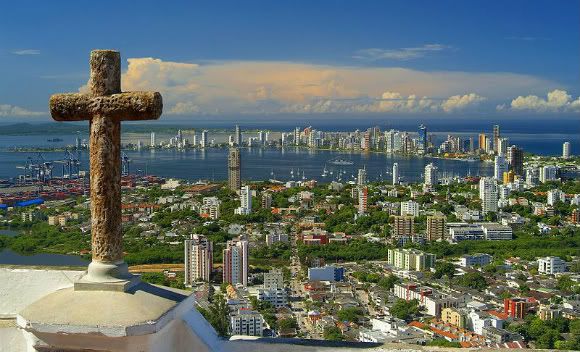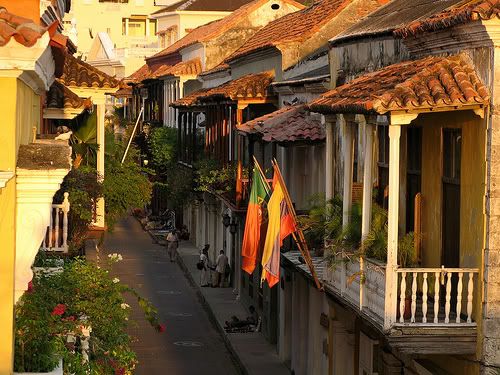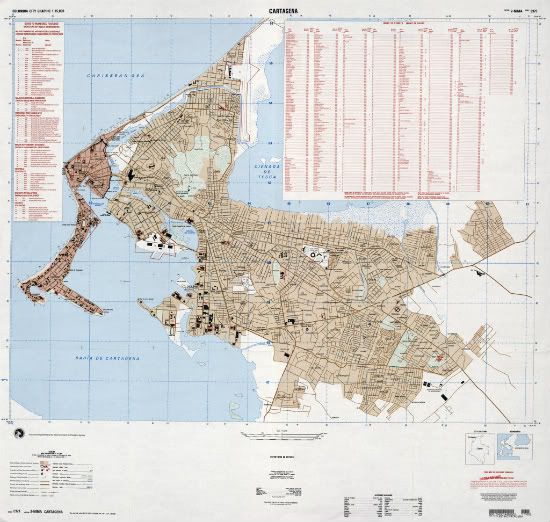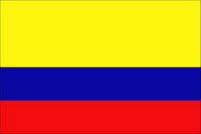|
Cartagena...Cartagena Colombia is a large Caribbean beach resort city on the northern coast of Colombia in the Caribbean Coast Region and capital of Bolívar Department. The city had a population of 892,545 as of the 2005 census, making it the fifth-largest city in Colombia and giving the cities urban area the status of fifth-largest urban area in Colombia. Flying into Colombia my first time, was into this old & historic city. The first look from the plane as we were landing is a memory that will last a lifetime. When I think about the veiw I had recalls that feeling that I had at that moment. I was excited, curious, amazed all at once with my pulse racing because like my wife...it was love at first sight! This is one city you'll enjoy taking pictures! Be sure to see the map below to find your way around. To see some cool photo's of Cartagena click here. Climate...This Caribbean city features a tropical wet and dry climate. Daily averages hover around 90% humidity, with rainy seasons typically in April–May and October–November. The climate tends to be hot and windy. The months of November to February tend to be more windy months, giving an extra cooling to the otherwise high tropical temperatures. This beautiful city is rarely touched by the hurricanes that decimate other Caribbean capitals like Havana, Santo Domingo, Kingston or San Juan. Although the city is in the Caribbean, the mainland is quite far south, isolating it from the wind currents that feed the hurricanes. The last hurricane to arrive at the city was Hurricane Santa, which had a strange arrival in 1988 and was debilitated after passing Panama. Click HERE for LARGER map of city. In this area is the Rafael Núñez International Airport, located in the neighborhood of Crespo, only ten minutes' drive from downtown or the old part of the city and fifteen minutes away from the modern area. Zona Norte, the area located immediately north of the airport, is widely recognized as the district with the greatest prospective long-term urban development. It is the setting for the Hotel Las Americas, the urban development office of Barcelona de Indias, and several educational institutions. The Downtown area has varied architecture, mainly a colonial style, but republican and Italian style buildings, such as the Cathedral's bell tower, can be seen. The official entrance to downtown Puerta del Reloj (Clock Gate), which comes out onto Plaza de los Coches (Square of the Carriages). A few steps farther is the Plaza de la Aduana (Customs Square), next to the mayor's office. Nearby is San Pedro Claver Square and the church also named for San Pedro, as well as the Museum of Modern Art. Nearby is the Plaza de Bolívar (Bolívar's Square) and the Palace of the Inquisition. Plaza de Bolivar (formerly known as Plaza de Inquisicion) is essentially a small park with a statue of Simón Bolívar in the center. This plaza is surrounded by some of the city's most elegant, colonial buildings, which have lovely balconies. Shaded outdoor cafes line the street. The Office of Historical Archives devoted to the cities history is not far away. Next to the archives is the Government Palace, the office building of the Governor of the Department of Bolivar. Across from the palace is the Cathedral of Cartagena, which dates back to the 16th century. Another religious building of significance is the restored Santo Domingo Church in front of Plaza Santo Domingo (Santo Domingo Square). The square is home to the sculpture Mujer Reclinada ("Reclining Woman"), a gift from the renowned Colombian artist Fernando Botero. Also of note is the Tcherassi Hotel, a 250 year old colonial mansion renovated by designer Silvia Tcherassi. The Claustro de Santa Teresa (Saint Theresa Cloister), which has been remodeled and has become a hotel is operated by Charleston Hotels. It has its own square, protected by the San Francisco Bastion. A 20-minute walk from downtown is the Castillo de San Felipe de Barajas, located in el Pie de la Popa (another neighborhood), the greatest fortress ever built by the Spaniards in their colonies. The original fort was constructed between 1639 and 1657 on top of San Lazaro Hill. In 1762 extensive expansion was undertaken, and the result is the current bastion. Numerous attempts to storm the fort were mounted, but it was never penetrated. An extensive system of tunnels is connected underground to distribute provisions and facilitate evacuation. The tunnels were all constructed in such a way as to make it possible to hear footsteps of an approaching enemy. Some of the tunnels are open for viewing today. San DiegoSan Diego was named after San Diego Convent, now known as the Beaux Arts School Building. In front of it is the Convent of the Nuns of the Order of Saint Claire, now the beautiful Hotel Santa Clara. In the surrounding area is Santo Toribio Church, the last church built in the Walled City and, next to it, Fernández de Madrid Square, honoring Cartagena's hero, José Fernández de Madrid, whose statue can be seen nearby. Inside the Old City is found Las Bóvedas (The Vaults), a construction attached to the walls of the Santa Catalina Fortress. From the top of this construction the Caribbean Sea is visible. Getsemaní neighborhoodAfrican people brought as slaves used to live in thisneighborhood, the most prominent place of which is Parque Centenario (Centenary Park), built in 1911 to commemorate a century of independence. Inside are found some interesting monuments, including one dedicated to the military. Parque Centenario also serves as a local police station and a mid-afternoon pulpit for aspiring evangelists. Over the years the park has acquired, through various means, a sloth, two gila monsters and a few monkeys. The Convention Center, Third Order Church and San Francisco Cloister are all located in the area. This area is also home to many popular clubs like La Carbonera and Mister Babilla. They decorate the night life and enhance the locals and tourists weekends. The Old City has the same architectural styles as the area surrounded by The Walls. The park is currently (September, 2011) undergoing a complete restoration, and is closed to the public. BocagrandeBocagrande (Big Mouth) is a much-sought-after area with many hotels, shops, restaurants, nightclubs and art galleries. It is located between Cartagena Bay to the east and the Caribbean Sea to the west, to include El Laguito (The Little Lake) and Castillogrande (Big Castle), two renowned neighborhoods. A big part of Bocagrande's appeal lies in its long beaches and a vibrant commercial activity found all along Avenida San Martín (Saint Martin Avenue). The beaches of Bocagrande, lying along the northern shore, are muddy. There are breakwaters about every 200 yards, and the azure of the Caribbean is lacking as the beach is very nearly at sea level and there is a lack of proper waste disposal in the city. A boat ride of about seven minutes takes visitors far enough out to sea to see the desired Caribbean color. On the bay side of the peninsula of Boca Grande is a spectacular seawalk. In the centre of the bay is a statue of the Virgin Mary. Contestants of the Miss Colombia Pageant go there to be seen during festival. Originally constructed for foreign oil workers, Bocagrande consists mostly the land acquired through land reclamation. Bocagrande is now considered the city's most popular area for tourists.
Tourist Sights and Attractions...
For a more in depth look at Cartagena, Colombia....please click this LINK.
|
Hola! :-)
Hello! This is Todd & Johana. Welcome to Colombia-Travel-Magazine. Like you, we both love Colombia & all it has to offer.
Thank you for visiting our Internet home! Add your voice to the world by telling others your stories, tips, likes, & news by easily sending C-T-M the form located at the bottom of this page.
Let's join together and erase all the false & negative stereotypes Hollywood has presented.
Come on, lets have some fun & share our good times with others!
We work on all our Sites from home. They are our main source of income...a great income!
Click the Site Sell link below right now to see how you too can work from home! Any questions send us an email & we'll try to help you along. We'll help you achieve Internet success!
eMAIL US HERE!















